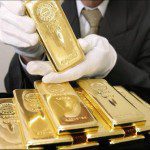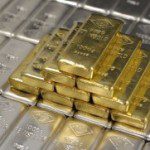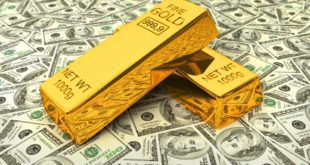Last year…saw gold’s greatest decline in 32 years…but I’m still confident that gold’s bullish fundamentals are still intact [and that what I said in my recently published book, $10,000 Gold*, still holds true. Here’s why]. still intact [and that what I said in my recently published book, $10,000 Gold*, still holds true. Here’s why].
So said Nick Barisheff, President & CEO of Bullion Management Group (www.bmgbullion.com), in his opening remarks of a speech** entitled Second Greatest Opportunity to Buy Gold that he made at this week’s prestigous 20th Annual Empire Club Investment Outlook luncheon in Toronto, Canada. [The following is presented by Lorimer Wilson, editor of munKNEE.com and may have been edited ([ ]), abridged (…) and/or reformatted (some sub-titles and bold/italics emphases) for the sake of clarity and brevity to ensure a fast and easy read. This paragraph must be included in any article re-posting to avoid copyright infringement.]Barisheff went on to say as follows: “Last year the COMEX futures exchange distorted gold prices, and provided investors with the second-greatest opportunity to buy gold since 2002. On April 12 the gold price declined by $150 per ounce, and on June 20 by $80 per ounce, because of the naked short selling of futures contracts. These precipitous drops triggered sell stops and margin calls, and the Western media jumped in to declare that the bull market in gold was over. In sharp contrast to the falling price of paper gold, the demand for physical gold soared. Many retail coin stores ran out of stock, and premiums rose as much as 20% for gold and 40% for silver. The lower gold price presents a problem for miners. Because average mine production costs exceed $1,200 per ounce, many high-cost producers will be forced to shut down, causing supply and demand pressure. Clearly, the physical price of gold cannot decline further for any length of time, and the correction is close to a bottom. In addition, the days of COMEX dominance in gold price setting are numbered, since monthly deliveries on the Shanghai Exchange already surpass mine supply. The main driver of the gold price is, and always has been, increasing money supply. ‘An increase in the money supply’ is the very definition of inflation, as it devalues currency and destroys purchasing power. If increasing money supply led to prosperity, Zimbabwe would be the richest country in the world. Gold Price & U.S. Debt Ceiling |
|
|||
| The chart above shows that gold and U.S. government debt have shared a lock-step relationship since 2001. Despite the divergence in 2013, over the longer term, gold and U.S. debt should return to the mean. Official U.S. public debt currently stands at $17.3 trillion. In order to bring the debt-to-gold relationship back into equilibrium, gold should be at $1,800 today. Since there is no political will to curtail debt increases or introduce austerity measures, I believe gold will surpass $1,800 and likely set new highs in 2014.…
Ever since President Nixon closed the gold window in 1971, the world has been in a global fiat currency experiment where every dollar in existence has been created through the issuance of new debt. Without the stability of gold backing, this has encouraged unbridled currency creation and reckless credit expansion at an exponentially increasing rate, taking fewer and fewer years to double.Since President Obama took office in 2008, U.S. cash debt has increased from about $10 trillion to over $17 trillion today. This figure does not take into consideration the very real $127 trillion in unfunded liabilities such as Medicare, the Prescription Drug Plan and Social Security, for which taxpayers will ultimately be responsible. Today, this works out to $1.1 million for each U.S. taxpayer.The debt build up is not limited to the U.S. but includes most western economies. The systemic risks that caused the financial meltdown in 2008 have gotten worse. The world’s financial system was almost destroyed because of $1.2 trillion in mortgage derivatives. Today interest rate derivatives alone are 450 times higher at $561trillion or 7 times global GDP. What could possibly go wrong? Long-term Treasuries ended 2013 pushing 3%, and will likely rise if the Fed’s tapering measures increase. In the U.S., a one 1% rise in interest rates translates to an additional $170 billion in additional annual interest costs, and increases both the debt and the deficit. All other Western central banks face similar situations. Interest rates at 3% in Japan will consume all the country’s tax revenues just to service interest payments. The bigger problem will be the decline in bond portfolios. In Europe, most banks hold significant amounts of sovereign debt as part of their capital. As interest rates increase, the value of their holdings will decrease incrementally. Due to high leverage ratios, some banks may need either bail-outs or bail-ins to shore up those capital ratios, and those same banks may find their interest rate derivatives have unexpected counterparty risks. The debilitating effect of the growing debt is clearly illustrated by the next chart. It shows that in the 1950s, for every dollar of debt increase, the economy grew by about $4. In 2013, for every dollar of debt increase, the economy has only grown by fifty cents. In real GDP over the last decade it has only grown by $0.08. You don’t need to be a mathematician to understand that this trend is not a recovery, and is unsustainable over the long term. GDP increase for every $1.00 Increase in Debt |
|
|||
| While demand for gold in the West dropped to an all-time low in 2013, the unprecedented demand for physical gold from Eastern buyers confirms that Eastern nations will no longer tolerate the debasement of their U.S. Treasury holdings.China bought a record 2,200 tonnes of gold last year. This is close to total global mine production for 2013. Many informed gold watchers feel this is a conservative figure, and the true figure will remain a mystery until China chooses to disclose it—likely in 2015.China is the world’s largest gold producer, and not only buys all of its own domestic production, but also buys through opaque sovereign wealth funds. In 2009 China announced its gold reserves at 1,054 tonnes. I would not be surprised to see that China owns over 5,000 tonnes by 2015. If we add the purchases of the other Far Eastern, Middle Eastern and Central Asian countries like Russia, far more physical gold was purchased than was mined.
The movement away from the U.S. dollar is intensifying. China has signed as many as 25 trade agreements that circumvent the U.S. dollar, and settle trade imbalances with the participants’ own currencies. This will continue to place downward pressure on demand for U.S. dollars. If the dollar loses its reserve currency status, America’s ability to print unlimited amounts of dollars without consequences will be over. Lifespan of Reserve Currencies |
|
|||
| The chart above shows the lifespan of the six reserve currencies that preceded the U.S. dollar; the average is 94 years…If we take the demise of the British pound as the world’s reserve currency in 1920 as our starting point, 2014 will mark the 94th year of the U.S. dollar’s lifespan...I firmly believe we are in the late stages of the U.S. dollar’s reign as world reserve currency.ConclusionConsidering the strengthening fundamentals we witnessed for gold in 2013, despite its poor price performance, it appears that an opportunity similar to that of 1976 is a strong possibility.Gold rose 450% from 1971 to 1974. It then retreated 43% over the next 18 months. Many investors lost confidence and sold their holdings vowing never to invest in gold again. However, during the next four years gold climbed 750%. A similar percentage increase from today’s price would see gold trading above $10,000 an ounce [$1,200 +450% = $10,200].
While there may still be price declines, I feel today’s situation is similar to that of the 1970s, and that we have the second-greatest opportunity to buy gold since 2002…” [Editor’s Note: The author’s views and conclusions in the above article are unaltered and no personal comments have been included to maintain the integrity of the original post. Furthermore, the views, conclusions and any recommendations offered in this article are not to be construed as an endorsement of such by the editor.]*About The Book: $10,000 Gold: Why Golds Inevitable Rise Is the Investor’s Safe Haven ** The Speech in its entirety: http://www.bmgbullion.com/document/5685/Second_Greatest_Opportunity_to_Buy_Gold.html
Related Articles: [Editor’s Note: The author’s views and conclusions in the above article are unaltered and no personal comments have been included to maintain the integrity of the original post. Furthermore, the views, conclusions and any recommendations offered in this article are not to be construed as an endorsement of such by the editor.] 1. Noonan: “Gold” War Has Replaced Cold War in China/Russia vs. U.S. Struggle for Economic Dominance With the Western central bankers conducting a clearance sale, and depleting their physical holdings in the process, China and Russia are importing gold at cheaper and cheaper price levels. In the war for gold, the East and West are still winning, but for vastly different reasons. Let me explain. Read More » 2. Noonan: Charts Suggest Lower Lows for Gold & Silver to Come in 2014 Because the natural laws of supply and demand do not apply to gold and silver, the only way we can track the influence of endless paper supply on the market is through the most reliable source, the market itself, and the best way to track the market is through charts.Let’s take a look at what they are conveying today. Read More » 3. Gold & Silver to Plunge – Again – Then Move Up Dramatically Later in 2014 Back in early May, 2013, I correctly forecast the lows in gold & silver which occurred 2 months later. Today, my new analyses of gold & silver indicates they both will show further weakness during the first quarter of 2014 before both jumping dramatically in price before the end of 2014. Below are the specific details of my forecasts (with charts) to help you reap substantial financial rewards should you wish to avail yourself of my insightful analyses. Read More » 4. Gold In 2014: Price Forecasts ($900 – $1,435) & Commentary Below are a series of forecasts and predictions of what 2014 could bring for the price of gold (as low as $900/ozt. & no higher than $1,435/ozt.) and the reasons why with interesting commentary by some individual investors and gold enthusiasts. Read More » 5. China Converting U.S. Dollar Debt Holdings Into Gold At Accelerating Rate China, Russia and other nations are exiting their dollar-denominated holdings in favor of gold. This action should put pressure on the dollar and U.S. treasuries, pushing not only central banks, but mainstream investors towards the safety of precious metals and other tangible assets that cannot be defaulted on. There will be a rush out of dollars and into assets with no counter-party risk, it is just a matter of how soon it happens. Read More » 6. Eric Sprott: Gold & Silver Could Double Within a Year & PM Stock Gains Could Be Gargantuan In this exclusive interview, Eric Sprott answers questions about the gold and silver market in which he suggests that gold could double in a year and, in the case of silver, could go up even more than that. As for gold and silver equities, he believes gains could be gargantuan, because the equities always double or triple the performance of physical gold. Here’s his reasoning. Read More » 7. Jim Willie: Gold Will Rise to $5,000/ozt. and Beyond & Silver Will Rise Multiples Higher In the last several months, the world economic crisis has entered a new elevated level of perma-crisis and constant tension, widely recognized as something more serious, more dangerous, and more risk-filled. This new normal is neither without resolution nor the attempt to resolve anything and, as such, is why the price of gold will rise to $5,000 per troy ounce, then higher, and at the same time, the silver price will rise multiples higher. Let me explain. Read More » 8. Gold Projected to Reach $4,000/ozt. Sometime Between Late 2015 & Mid 2017! Here’s My Rationale I am not predicting a future price of gold or the date that gold will trade at $4,000, but I am making a projection based on rational analysis that indicates a likely time period for gold to trade at $4,000 per troy ounce. Yes, $4,000 gold is completely plausible if you assume the following: 9. New Analysis Suggests a Parabolic Rise in Price of Gold to $4,380/ozt. According to my 2000 calculations, if interest rates and inflation stay constant over the next 2 years, we could expect to see (with 95.2% certainty) a parabolic peak price for gold of $4,380 per troy ounce by then! Let me explain what assumptions I made and the methods I undertook to arrive at that number and you can decide just how realistic it is. Words: 740 10. Coming Move In Gold Will See It Reach $3,200 by Late 2014 or Early 2015 The breakdown after the QE4 announcement, and now the extreme move into a yearly cycle low has, I daresay, convinced everyone that the gold bull is over. I would argue that it is impossible for the gold bull to be over as long as central banks around the world continue to debase their currencies [and that] gold is just creating the conditions – a T-1 pattern – necessary for its next leg up to what I expect to be…around $3200 sometime in late 2014 or early 2015. [Let me explain.] Words: 560; Charts: 3
|
 munKNEE.com Your Key to Making Money
munKNEE.com Your Key to Making Money












From: https://munknee.com/gold-2014-price-forecasts-900-1435-commentary/#comment-71523
I’m glad that Richard Russell: agrees with me, even though I’m less famous!
I now look to PM’s to be THE investment for the future, because industry uses Gold, Silver and most of the other PM’s (along with Copper, which I feel will be the next addition to the PM list) because paper money cannot every fill that demand!
The global race for resources is on and the Chinese are way out front in their effort to corner the market on just about everything of true value, which includes PM’s…
I thought that the US dollar became the worlds reserve currency under Bretton Woods in 1944? Where does this 1920 come from? Nonetheless, I do agree with the fact that we are in the end game.
Mark D
I agree with you!
From 12/14/13: https://munknee.com/noonan-heres-why-silver-is-so-low-what-to-do-about-it/
Naked Shorts Exposed!
Yes, I agree that the PM market is being manipulated by the Central Banks and their close friends the Big Banks; sooner or later all the things they are juggling to keep the lid on this can of fiscal worms is going to end and then we will se PM’s suddenly restored to there rightful value as everyone scrambles to “fill” the paper trades, which will cause the values of PM’s to skyrocket!
A good example of what may happen very soon is what happened to VW stock when investors were using naked shorts to drive VW stock downward. Then suddenly there was none to be had, (since VW was quietly buying up as much of it as they could get on the quiet) and those not holding physical shares had to pay what was then enormous amounts to settle their accounts, which made VW stock very valuable!